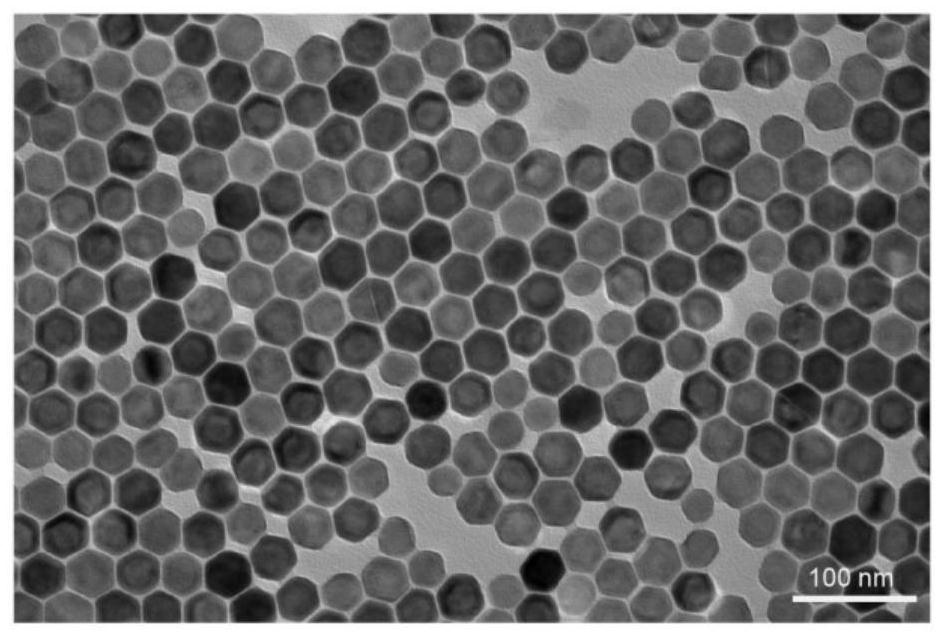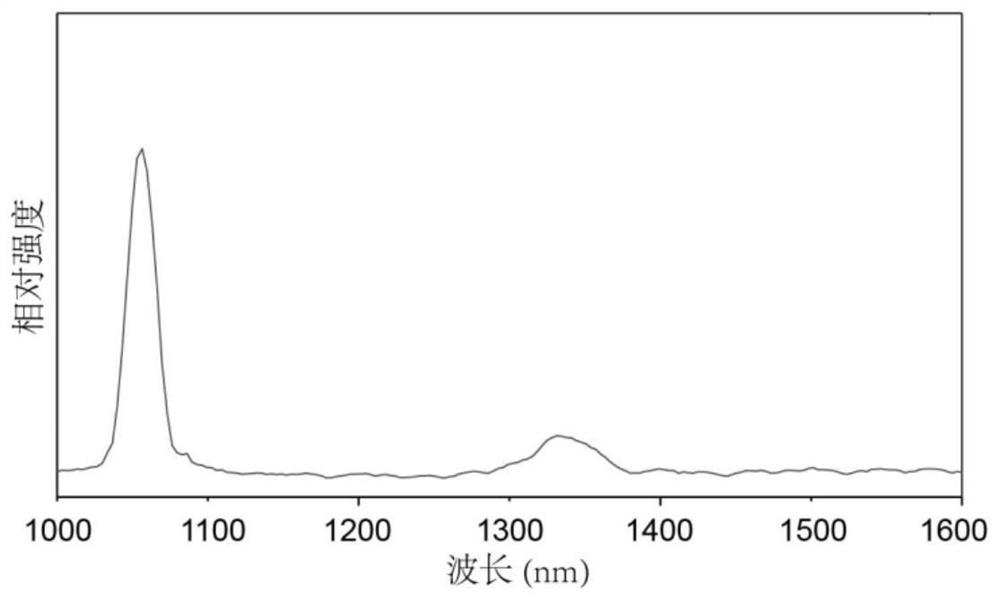Wavelength-adjustable near-infrared second window long afterglow nanoprobe and synthesis method thereof
A technology of nanoprobes and synthesis methods, applied in nanotechnology, nanotechnology, nanooptics, etc., can solve problems such as limiting long afterglow probes, avoid background noise in biological tissues, improve resolution and signal-to-noise ratio, and widen The effect of the application foreground
- Summary
- Abstract
- Description
- Claims
- Application Information
AI Technical Summary
Problems solved by technology
Method used
Image
Examples
Embodiment 1
[0029] NaYF 4 :1%Nd@NaYF 4 Preparation of near-infrared second window 1064 nm monochromatic emission long-persistence nanocrystals. Specific steps are as follows.
[0030] (1) Preparation of shell precursor; preparation of Y-OA (0.1 M) precursor: 5.0 mM YCl 3 Rare earth salts, 20.0 mL of OA and 30.0 mL of ODE were loaded into a 100 mL three-neck flask, and then heated to 140 °C under vacuum for 60 minutes; after cooling to room temperature, a 0.1 M clear and transparent Ln-OA precursor was obtained ;
[0031] Na-TFA-OA (0.4 M) precursor: put 20.0 mM Na-TFA rare earth salt, 50.0 mL of OA into a 100 mL three-necked flask, then heat to 70 °C under vacuum for 60 minutes; cool to room temperature After that, 0.4 M clear and transparent Na-TFA-OA precursor was obtained.
[0032] (2) NaYF 4 : Synthesis of 1%Nd Long Persistence Nanocrystalline Nuclei
[0033] First add 2 (1-0.01) mM YCl 3 and 0.02 mM NdCl 3 Added to a 100 mL three-neck flask containing 50.0 mL OA / ODE (volume ...
Embodiment 2
[0038] NaGdF 4 :3%Er@NaYF 4 Preparation of near-infrared second window 1525 nm monochromatic emission with long persistence nanocrystals. Specific steps are as follows.
[0039] (1) Preparation of shell precursor; preparation of Y-OA (0.1 M) precursor: 5.0 mM YCl 3 Rare earth salts, 20.0 mL of OA and 30.0 mL of ODE were loaded into a 100 mL three-neck flask, and then heated to 140 °C under vacuum for 60 minutes; after cooling to room temperature, a 0.1 M clear and transparent Ln-OA precursor was obtained ;
[0040] Na-TFA-OA (0.4 M) precursor: put 20.0 mM Na-TFA rare earth salt, 50.0 mL of OA into a 100 mL three-necked flask, then heat to 70 °C under vacuum for 60 minutes; cool to room temperature After that, 0.4 M clear and transparent Na-TFA-OA precursor was obtained.
[0041] (2) NaGdF 4 : Synthesis of 3% Er Long Persistence Nanocrystalline Nuclei
[0042] First add 2 (1-0.03) mM GdCl 3 and 0.06 mM ErCl 3 Added to a 100 mL three-neck flask containing 20.0 mL OA / ODE...
Embodiment 3
[0047] NaYF 4 :1%Nd,1%Ho,3%Er@NaGdF 4 Preparation of near-infrared second window 1064 nm, 1180 nm and 1525 nm three-color emission long-lasting nanocrystals. Specific steps are as follows.
[0048] (1) Preparation of shell precursor; preparation of Gd-OA (0.1 M) precursor: 5.0 mM GdCl 3 Rare earth salts, 20.0 mL of OA and 30.0 mL of ODE were loaded into a 100 mL three-neck flask, and then heated to 140 °C under vacuum for 60 minutes; after cooling to room temperature, a 0.1 M clear and transparent Ln-OA precursor was obtained ;
[0049] Na-TFA-OA (0.4 M) precursor: put 20.0 mM Na-TFA rare earth salt, 50.0 mL of OA into a 100 mL three-necked flask, then heat to 70°C under vacuum for 60 minutes; cool to room temperature After that, 0.4 M clear and transparent Na-TFA-OA precursor was obtained.
[0050] (2) NaYF 4 : Synthesis of 1%Nd, 1%Ho, 3%Er Long Persistence Nano-Crystal Nuclei
[0051] First add 2 (1-0.05) mM YCl 3 , 0.02 mM NdCl 3 , 0.02 mM HoCl 3 and 0.06 mM ErCl ...
PUM
| Property | Measurement | Unit |
|---|---|---|
| thickness | aaaaa | aaaaa |
| thickness | aaaaa | aaaaa |
| size | aaaaa | aaaaa |
Abstract
Description
Claims
Application Information
 Login to View More
Login to View More - R&D
- Intellectual Property
- Life Sciences
- Materials
- Tech Scout
- Unparalleled Data Quality
- Higher Quality Content
- 60% Fewer Hallucinations
Browse by: Latest US Patents, China's latest patents, Technical Efficacy Thesaurus, Application Domain, Technology Topic, Popular Technical Reports.
© 2025 PatSnap. All rights reserved.Legal|Privacy policy|Modern Slavery Act Transparency Statement|Sitemap|About US| Contact US: help@patsnap.com



